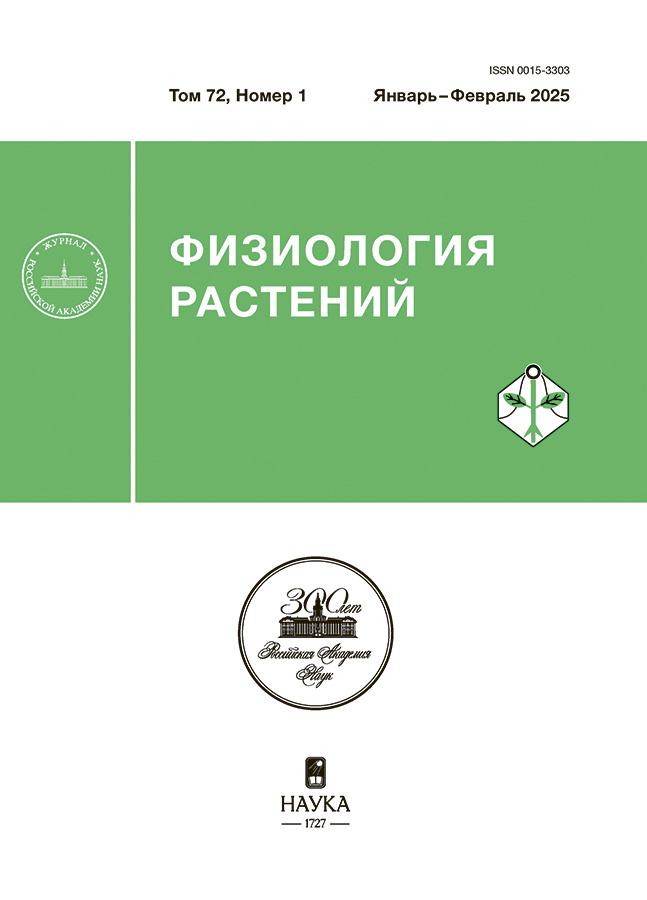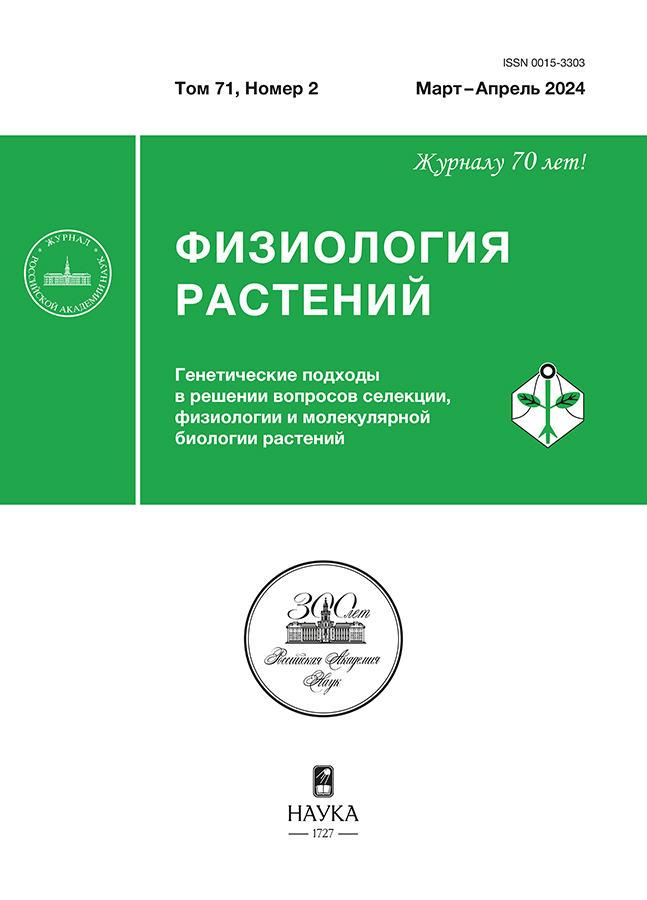Метаболизм каллозы в волокнах льна при гравиответе: анализ экспрессии генов
- Authors: Ибрагимова Н.Н.1, Мокшина Н.Е.1
-
Affiliations:
- Казанский институт биохимии и биофизики – обособленное структурное подразделение Федерального государственного бюджетного учреждения науки Федерального исследовательского центра “Казанский научный центр Российской академии наук”
- Issue: Vol 71, No 2 (2024)
- Pages: 216-227
- Section: ЭКСПЕРИМЕНТАЛЬНЫЕ СТАТЬИ
- URL: https://cardiosomatics.ru/0015-3303/article/view/648225
- DOI: https://doi.org/10.31857/S0015330324020086
- EDN: https://elibrary.ru/OAXKXV
- ID: 648225
Cite item
Abstract
Двигательные реакции растений, относящиеся к тропизмам, обычно осуществляются с использованием механизмов роста растяжением. Однако в данном исследовании изучался гравитропизм на уровне клеток (первичные флоэмные волокна), закончивших свой рост и формирующих утолщенную третичную клеточную стенку. Проведены инвентаризация и анализ экспрессии генов ферментов, ответственных за метаболизм каллозы, на разных стадиях развития флоэмных волокон льна (Linum usitatissimum L.) и при гравиответе. Выявлены гены предполагаемых β-1,3-глюкансинтаз (GSLs) и β-1,3-глюканаз (BGs), имеющие дифференциальный характер экспрессии в исследуемых клетках, среди которых отмечены гены с максимальным уровнем экспрессии на определенной стадии развития. В основном при гравитропизме экспрессия генов β-1,3-глюкансинтаз была понижена, тогда как для генов β-1,3-глюканаз были характерны различные профили экспрессии, среди которых выявлены гены с повышенным уровнем экспрессии только при гравиответе (LusBG1 и LusBG3). Полученные данные позволили предположить наличие активного метаболизма каллозы в клеточной стенке исследуемых волокон на разных стадиях развития и доминирование деградации каллозы в ходе гравиответа. Результаты работы закладывают основу для дальнейших исследований функции каллозы в развитии волокон и реализации двигательной реакции растений.
Full Text
About the authors
Н. Н. Ибрагимова
Казанский институт биохимии и биофизики – обособленное структурное подразделение Федерального государственного бюджетного учреждения науки Федерального исследовательского центра “Казанский научный центр Российской академии наук”
Author for correspondence.
Email: nibra@yandex.ru
Russian Federation, Казань
Н. Е. Мокшина
Казанский институт биохимии и биофизики – обособленное структурное подразделение Федерального государственного бюджетного учреждения науки Федерального исследовательского центра “Казанский научный центр Российской академии наук”
Email: nibra@yandex.ru
Russian Federation, Казань
References
- Moulia B., Fournier M. The power and control of gravitropic movements in plants: a biomechanical and systems biology view // J. Exp. Bot. 2009. V. 60. P. 461. https://doi.org/10.1093/jxb/ern341
- Gorshkova T., Chernova T., Mokshina N., Ageeva M., Mikshina P. Plant “muscles”: fibers with a tertiary cell wall // New Phytol. 2018. V. 218. P. 66. https://doi.org/10.1111/nph.14997
- Almeras T., Derycke M., Jaouen G., Beauchene J., Fournier M. Functional diversity in gravitropic reaction among tropical seedlings in relation to ecological and developmental traits // J. Exp. Bot. 2009. V. 60. P. 4397. https://doi.org/10.1093/jxb/erp276
- Kojima M., Becker V.K., Altaner C.M. An unusual form of reaction wood in Koromiko [Hebe salicifolia G. Forst. (Pennell)], a southern hemisphere angiosperm // Planta. 2012. V. 235. P. 289. https://doi.org/10.1007/s00425-011-1503-z
- Fisher J.B. Anatomy of axis contraction in seedlings from a fire prone habitat // Am. J. Bot. 2008. V. 95. P. 1337. https://doi.org/10.3732/ajb.0800083
- Schreiber N., Gierlinger N., Putz N., Fratz P., Neinhuis C., Burgert I. G-fibres in storage roots of Trifolium pratense (Fabaceae): tensile stress generators for contraction // Plant J. 2010. V. 61. P. 854. https://doi.org/10.1111/j.1365-313X.2009. 04115.x
- Ibragimova N.N., Ageeva M.V., Gorshkova T.A. Development of gravitropic response: unusual behavior of flax phloem G-fibers // Protoplasma. 2017. V. 254. P. 749. https://doi.org/10.1007/s00709-016-0985-8
- Waterkeyn L., Caeymaex S., Decamps E. Callose in compression wood tracheids of Pinus and Larix // Bull. Soc. Roy. Bot. Belg. 1982. V. 115. P. 149.
- Chen X.-Y., Kim J.-Y. Callose synthesis in higher plants // Plant Signal. Behav. 2009. V. 4. P. 489. https://doi.org/10.4161/psb.4.6.8359
- Usak D., Haluška S., Pleskot R. Callose synthesis at the center point of plant development – an evolutionary insight // Plant Physiol. 2023. V. 193. P. 54. https://doi.org/10.1093/plphys/kiad274
- Pirselova B., Matusikova I. Callose: the plant cell wall polysaccharide with multiple biological functions // Acta Physiol. Plant. 2013. V. 35. P. 635. https://doi.org/10.1007/s11738-012-1103-y
- Richmond T.A., Somerville C.R. The cellulose synthase superfamily // Plant Physiol. 2000. V. 124. P. 495. https://doi.org/10.1104/pp.124.2.495
- Verma D.P.S, Hong Z. Plant callose synthase complexes // Plant Mol. Biol. 2001. V. 47. P. 693. https://doi.org/10.1023/A:1013679111111
- Lombard V., Ramulu H.G., Drula E., Coutinho P.M., Henrissat B. The carbohydrate-active enzymes database (CAZy) in 2013 // Nucleic Acids Res. 2014. V. 42. P. D490. https://doi.org/10.1093/nar/gkt1178
- Perrot T., Pauly M., Ramírez V. Emerging roles of β-glucanases in plant development and adaptative responses // Plants. 2022. V. 11. P. 1119. https://doi.org/10.3390/plants11091119
- Snegireva A.V., Ageeva M.V., Amenitskii S.I., Chernova T.E., Ebskamp M., Gorshkova T.A. Intrusive growth of sclerenchyma fibers // Russ. J. Plant Physiol. 2010. V. 57. P. 342. https://doi.org/10.1134/S1021443710030052
- Gorshkova T., Chernova T., Mokshina N., Gorshkov V., Kozlova L., Gorshkov O. Transcriptome analysis of intrusively growing flax fibers isolated by laser microdissection // Sci. Rep. 2018. V. 8. P. 14570. https://doi.org/10.1038/s41598-018-32869-2
- Mokshina N., Gorshkov O., Takasaki H., Onodera H., Sakamoto S., Gorshkova T., Mitsuda N. FIBexDB: a new online transcriptome platform to analyze development of plant cellulosic fibers // New Phytol. 2021. V. 231. P. 512. https://doi.org/10.1111/nph.17405
- Cui W., Lee J.-Y. Arabidopsis callose synthases CalS1/8 regulate plasmodesmal permeability during stress // Nat. Plants. 2016. V. 2. P. 16034. https://doi.org/10.1038/nplants.2016.34
- Teea E.E., Johnstona M.G., Papp D., Faulknera C.A. PDLP-NHL3 complex integrates plasmodesmal immune signaling cascades // PNAS. 2023. V. 120. e2216397120. https://doi.org/10.1073/pnas.2216397120
- Sevilem I., Miyashima S., Helariutta Y. Cell-to-cell communication via plasmodesmata in vascular plants // Cell Adh. Migr. 2013. V. 7. P. 27. https://doi.org/10.4161/cam.22126
- Saatian B., Kohalmi S.E., Cui Y. Localization of Arabidopsis Glucan Synthase-Like 5, 8, and 12 to plasmodesmata and the GSL8-dependent role of PDLP5 in regulating plasmodesmal permeability // Plant Signal. Behav. 2023. V. 18. P. 2164670. https://doi.org/10.1080/15592324.2022.2164670
- Xie B., Wang X., Zhu M., Zhang Z., Hong Z. Cals7 encodes a callose synthase responsible for callose deposition in the phloem: a phloemspecific callose synthase // Plant J. 2011. V. 65. P. 1. https://doi.org/10. 1111/j.1365-313X.2010.04399
- Gorshkov O., Mokshina N., Ibragimova N., Ageeva M., Gogoleva N., Gorshkova T. Phloem fibres as motors of gravitropic behaviour of flax plants: level of transcriptome // Funct. Plant Biol. 2018. V. 45. P. 203. https://doi.org/10.1071/FP16348
- Ellinger D., Naumann M., Falter C., Zwikowics C., Jamrow T., Manisseri C., Somerville S.C., Voigt C.A. Elevated early callose deposition results in complete penetration resistance to powdery mildew in Arabidopsis // Plant Physiol. 2013. V. 161. P. 1433. https://doi.org/10.1104/pp.112.211011
- Naumann M., Somerville S., Voigt C. Differences in early callose deposition during adapted and non-adapted powdery mildewinfection of resistant Arabidopsis lines // Plant Signal. Behav. 2013. V. 8. e24408. https://doi.org/10.4161/psb.24408
- Enns L.C., Kanaoka M.M., Torii K.U., Comai L., Okada K., Cleland R.E. Two callose synthases, GSL1 and GSL5, play an essential and redundant role in plant and pollen development and in fertility // Plant Mol. Biol. 2005. V. 58. P. 333. https://doi.org/10.1007/s11103-005-4526-7
- Zhou C., Yin Y., Dam P., Xu Y. Identification of novel proteins involved in plant cell-wall synthesis based on protein-protein interaction data // J. Proteome Res. 2010. V. 9. P. 5025. https://doi.org/10.1021/pr100249c
- Sakuma Y., Maruyama K., Osakabe Y., Qin F., Seki M., Shinozaki K., Yamaguchi-Shinozaki K. Functional analysis of an Arabidopsis transcription factor, DREB2A, involved in drought-responsive gene expression // Plant Cell. 2006. V. 18. P. 1292. https://doi.org/10.1105/tpc.105.035881
- Levy A., Erlanger M., Rosenthal M., Epel B.L. A plasmodesmata-associated beta-1,3-glucanase in Arabidopsis // Plant J. 2007. V. 49. P. 669. https://doi.org/10.1111/j.1365-313X.2006.02986.x
- Ho L.H., Giraud E., Uggalla V., Lister R., Clifton R., Glen A., Thirkettle-Watts D., Van Aken O., Whelan J. Identification of regulatory pathways controlling gene expression of stress-responsive mitochondrial proteins in Arabidopsis // Plant Physiol. 2008. V. 147. P. 1858. https://doi.org/10.1104/pp.108.121384
- Borner G.H., Lilley K.S., Stevens T.J., Dupree P. Identification of glycosylphosphatidylinositol-anchored proteins in Arabidopsis. A proteomic and genomic analysis // Plant Physiol. 2003. V. 132. P. 568. https://doi.org/10.1104/pp.103.021170
- Ko J.H., Yang S.H., Park A.H., Lerouxel O., Han K.H. ANAC012, a member of the plant-specific NAC transcription factor family, negatively regulates xylary fiber development in Arabidopsis thaliana // Plant J. 2007. V. 50. P. 1035. https://doi.org/10.1111/j.1365-313X.2007.03109.x
- Zavaliev R., Levy A., Gera A., Epel B.L. Subcellular dynamics and role of Arabidopsis β-1,3-glucanases in cell-to-cell movement of tobamoviruses // Mol. Plant Microbe Interact. 2013. V. 26. P. 1016. https://doi.org/10.1094/MPMI-03-13-0062-R
Supplementary files

















